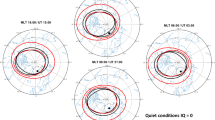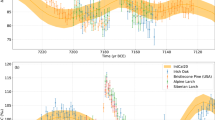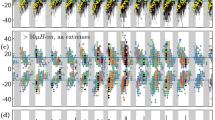Abstract
THERE has been much speculation in recent years concerning the height of the irregularities in the Earth's ionosphere which are responsible for the scintillations in the signals received from discrete sources of cosmic radio emission. Hewish1 concluded that the irregularities are at a height of about 400 km., whereas Booker2 has recently suggested that they are substantially lower—between the E and F regions; other authors have found correlation between scintillation activity and the occurrence of spread-F and sporadic-E conditions.
This is a preview of subscription content, access via your institution
Access options
Subscribe to this journal
Receive 51 print issues and online access
$199.00 per year
only $3.90 per issue
Buy this article
- Purchase on Springer Link
- Instant access to full article PDF
Prices may be subject to local taxes which are calculated during checkout
Similar content being viewed by others
References
Hewish, A., Proc. Roy. Soc., A, 214, 494 (1952).
Booker, H. G., Proc. Inst. Radio Eng., 46, 298 (1958).
Author information
Authors and Affiliations
Rights and permissions
About this article
Cite this article
SLEE, O. Radio Scintillations of Satellite 1958α. Nature 181, 1610–1612 (1958). https://doi.org/10.1038/1811610b0
Issue Date:
DOI: https://doi.org/10.1038/1811610b0
Comments
By submitting a comment you agree to abide by our Terms and Community Guidelines. If you find something abusive or that does not comply with our terms or guidelines please flag it as inappropriate.



